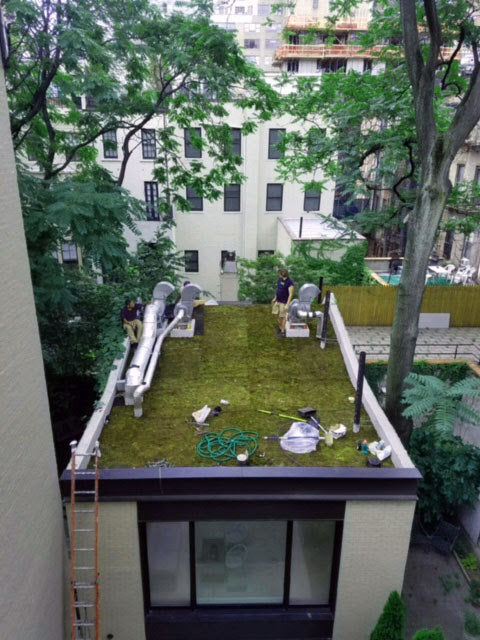Moss Roofs

1. FULLY GROWN MOSS MATS
Moss Acres has now furnished moss for several green roof projects. These have been successfully i nstalled utilizing a variety of different methods described below. Please call us at 866 GET MOSS or by email at info@mossacres.com to discuss your project in detail - it is important we understand the application so we can recommend the best solution for your project.

1) Lightweight – Ideal for green roofs on buildings with load bearing constraints
2) Lower Cost - Moss mats are shipped dry and are very easy to transport, handle, and install. The material, labor and staging expense savings can be significant.
3 ) Low Maintenance - Moss requires no fertilization, pesticides or even watering to survive. Moss has no roots and receives all nutrients and moisture through it’s leaves from rainfall.
4) Water Retention & Insulating Properties – Green roof systems comprised of moss mats and a water retention underlayment combine for significant storm water holding capacity, protect the roofing membrane, and provide significant insulating capabilities.
5) Versatile: Sun or Shade - Various species of moss are available on our mats for most any type of living roof location – from full sun to full shade.
6) Appearance - The vibrant shades of green produced by moss make it an ideal choice for any green roof design.
7) Pollution and C02 abatement. Moss has amazing properties when it comes to absorbing and retaining pollutants and carbon dioxide. Easier breathing with cleaner air.
8) Reduced Heat Island Effect - For urban areas, cool, green moss can dramatically lower surrounding air temperature.
A moss covered green roof using our fully grown moss mats was incorporated into the green roof design for a granite "fireplace house" along the banks of crystal clear Adirondack Mountain lake. The project was collaborated on with green roof specifiers Roof Meadow and was installed by Recover Green Roofs. For this green roof system the "Watergrip" water retention system was utilized beneath sheets and clumps of various shade loving mosses and ferns. Transplant netting is barely visible, and was also installed atop the moss to keep it in place. This same technique would also work atop our capillary mats and/or the "Enka Retain & Drain system".

A wedding and events venue in New Hope, PA - "Holly Hedge" installed a moss living roof on a small children's cottage made of cordwood. The moss was laid directly over synthetic felt capillary mats and Enka Drain Retain & Drain drainage mat. The waterproofing for the green roof is EPDM rubber. There is a drip line at the peak set on a timer. Transplant netting was used to protect the moss from birds that might try to flip the moss over in search of bugs or worms, and to keep the moss from blowing off until it has time to knit to the mats. The sheet mosses are flourishing on this living roof installation.
2. MOSS FRAGMENTS

For several years, Moss Acres conducted several experiments with moss on a wide range of green roofing soil mediums and on several flat, shady area roofs. The results have been very favorable. We have found that by shredding various varieties of sheet mosses and broadcasting these fragments over the expanded green roof aggregate, we have been able to establish moss that not only knits together quickly, but also grows into and amongst the aggregate, locking the moss to the roof.
The keys to success have been keeping the moss fragments moist (gel powder is first lightly raked into the roofing aggregate) and choosing a relatively shaded location, while utilizing a relatively high coverage rate of 75% - 85%.
Moss has many advantages for green roofs:
- Requires less roofing soil medium - only 1.5" deep or so
- Retains 10 x its weight in water
- Thrives in shade produced by trees or building shadows
- Drought tolerant once established
- Rapid growth rate: 6 - 12 months for full coverage

This project was at the residence of none other than Dave Benner, moss pioneer and father of Moss Acres owner, Al Benner. (photo above shows moss 18 months after "inoculation") This roof, over a section of the house measuring 550 square feet, has a 10° pitch and is well shaded under a large beech tree. Prior to installation the roof had been covered with an EPDM rubber roof. For this installation, the entire section was covered with a Colbond Enkadrain “retain and drain” mat system, a Rooflite® extensive growing medium (1.5"), and a mix of pre-shredded hypnum and fern mosses that were applied to achieve a 75% coverage rate. Prior to spreading the moss, which was done by hand, a water-retention gel was raked into the growing medium. Special thanks for on-site support to Charlie Miller and his team from Roofscapes in Philadelphia, PA.
Another green roof application involving Moss Acres was at the College of Human Ecology at Cornell University where four pre-planted rooftop boxes were custom planted and then delivered to the University.







